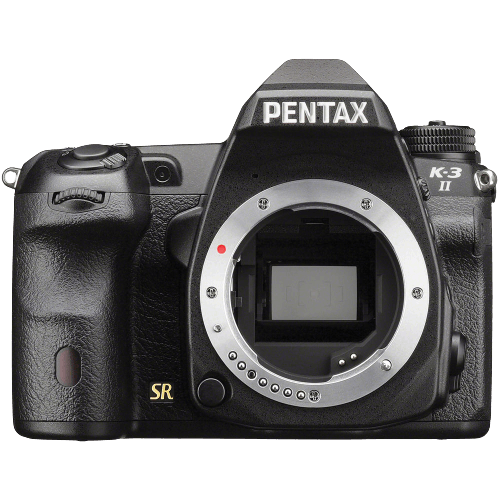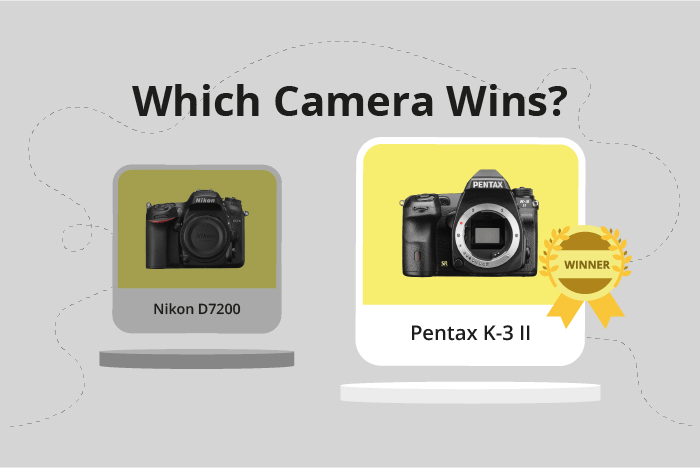Nikon D7200 vs Pentax K-3 II Comparison
Nikon D7200

Pentax K-3 II

The Pentax K-3 II takes the lead with a score of 69/100, while the Nikon D7200 trails closely with 68/100. Both DSLR cameras share similarities, such as their release in 2015, with the Nikon D7200 announced on 03/02/2015 and the Pentax K-3 II on 04/23/2015. They also have comparable sizes, with the Nikon D7200 measuring 136 x 107 x 76mm and the Pentax K-3 II at 131 x 100 x 77mm.
The Pentax K-3 II outshines the Nikon D7200 with its lower launch price of $1100 compared to the D7200’s $1200. However, the Nikon D7200 is slightly lighter, weighing 765g (1.69lbs) versus the Pentax K-3 II’s 800g (1.76lbs).
Taking into account the specifications, the Pentax K-3 II offers better value for money, while the Nikon D7200 provides a lighter option for photographers. Both cameras serve as strong contenders in the DSLR market.
Nikon D7200 vs Pentax K-3 II Overview and Optics
The Pentax K-3 II emerges as the winner in the optics comparison with a score of 74/100, outperforming the Nikon D7200, which scored 71/100. Both cameras share several specifications, such as a 24-megapixel CMOS sensor, an APS-C sensor size, and compatibility with their respective brand’s lens mounts, the Nikon F DX and Pentax KAF.
The Pentax K-3 II surpasses the Nikon D7200 in certain aspects. Its shooting speed of 8.3 frames per second is faster than the D7200’s 6 frames per second, providing better performance in capturing fast-moving subjects. Additionally, the K-3 II has built-in image stabilization, which the D7200 lacks. This feature helps reduce camera shake, resulting in sharper images, especially in low light conditions or when using telephoto lenses.
However, the Nikon D7200 has a higher DXOMARK sensor score of 87, compared to the Pentax K-3 II’s score of 80. This indicates that the D7200’s sensor performs better in terms of color depth, dynamic range, and low-light ISO performance. The D7200 also has the advantage of using an Expeed 4 processor, which contributes to faster image processing and better noise reduction.
Taking these factors into consideration, the Pentax K-3 II offers superior shooting speed and image stabilization, making it an excellent choice for action and sports photography. On the other hand, the Nikon D7200 boasts a better sensor performance and image processing, which is advantageous for photographers who prioritize image quality and low-light performance. Ultimately, the choice between these two cameras depends on the specific needs and preferences of the photographer.
Nikon D7200 vs Pentax K-3 II Video Performance
The Nikon D7200 and the Pentax K-3 II both score 70/100 for their video capabilities, making them equally matched in this aspect. They share several key specifications, including Full HD video resolution, max video dimensions of 1920 x 1080, and a max video frame rate of 60fps. Additionally, both cameras have built-in time-lapse functionality.
Despite the equal scores, there are areas where each camera performs better. The Nikon D7200 excels in its autofocus system, providing smoother and more accurate focus tracking during video recording. This feature is particularly useful for capturing moving subjects or when changing focus between different subjects in a scene. Additionally, the D7200’s larger buffer capacity allows for longer continuous video recording, making it more suitable for extended filming sessions.
On the other hand, the Pentax K-3 II has a few advantages of its own. The camera’s in-body image stabilization system provides steadier footage, reducing the impact of camera shake during handheld video recording. This feature is beneficial for users who frequently shoot video without a tripod or other stabilization equipment. Furthermore, the K-3 II’s weather-sealed construction ensures reliable performance in various environmental conditions, making it a more versatile option for outdoor video recording.
Based on these factors, the Nikon D7200 and Pentax K-3 II are evenly matched in terms of video capabilities. The D7200 offers better autofocus performance and longer recording times, while the K-3 II provides superior image stabilization and weather resistance. Users should consider their specific needs and preferences when choosing between these two cameras for video recording purposes.
Nikon D7200 vs Pentax K-3 II Features and Benefits
The Nikon D7200 and Pentax K-3 II both have a feature score of 59/100. Despite having the same score, these cameras have unique features that set them apart from each other.
Both cameras have a screen size of 3.2 inches, but the Nikon D7200 has a higher screen resolution of 1,228,800 dots compared to the Pentax K-3 II’s 1,037,000 dots. Neither camera has a touchscreen or flip screen, and both lack Bluetooth capabilities.
The Nikon D7200 excels in connectivity, as it has built-in WiFi, allowing for easy sharing and remote control of the camera. This feature is not present in the Pentax K-3 II, which may be a deal-breaker for those who prioritize wireless connectivity.
On the other hand, the Pentax K-3 II has built-in GPS, which is useful for geotagging images and tracking the location of shots. This feature is absent in the Nikon D7200. For photographers who value location data, the Pentax K-3 II is the better choice.
In conclusion, the Nikon D7200’s advantage lies in its WiFi connectivity and higher screen resolution, making it ideal for photographers who prioritize image quality and convenience in sharing images. The Pentax K-3 II stands out for its GPS functionality, catering to those who require location information in their photography. Both cameras offer unique features that cater to different photography needs, and the choice between them depends on individual priorities and preferences.
Nikon D7200 vs Pentax K-3 II Storage and Battery
The Nikon D7200 surpasses the Pentax K-3 II in storage and battery with a score of 79/100, while the Pentax K-3 II scores 65/100. Both cameras share certain specifications, including two memory card slots and compatibility with SD, SDHC, and SDXC cards. Neither camera supports USB charging.
The Nikon D7200 outperforms the Pentax K-3 II with a significantly longer battery life of 1110 shots, compared to the K-3 II’s 720 shots. Its battery type is the EN-EL15, contributing to its superior battery performance.
On the other hand, the Pentax K-3 II uses a D-LI90 battery type, resulting in a shorter battery life. However, there are no other advantages in storage and battery for the K-3 II over the D7200.
Considering the longer battery life, the Nikon D7200 stands out as the better choice in terms of storage and battery capabilities. The Pentax K-3 II falls short in this aspect, making the D7200 a more reliable option for extended shooting sessions.
Nikon D7200 vs Pentax K-3 II – Our Verdict
Are you still undecided about which camera is right for you? Have a look at these popular comparisons that feature the Nikon D7200 or the Pentax K-3 II:

